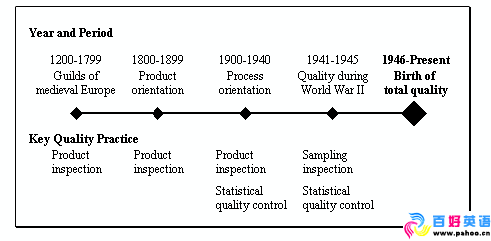此主题相关图片如下: document.body.clientWidth-333)this.width=document.body.clientWidth-333" border=0> document.body.clientWidth-333)this.width=document.body.clientWidth-333" border=0>
The birth of total quality in the United States was in direct response to a quality revolution in Japan following World War II. The Japanese quality revolution After the war, major Japanese manufacturers converted from producing military goods for internal use to civilian goods for trade. Unfortunately, Japan’s reputation for shoddy exports preceded the products, and they were subsequently shunned by international markets. This led to Japanese organizations exploring new ways of thinking about quality. They welcomed input from foreign companies and lecturers, including American quality experts W. Edwards Deming and Joseph M. Juran, and adopted unprecedented strategies for creating a revolution in quality. Japan’s strategies represented the new “total quality” approach. Rather than relying purely on product inspection, total quality focused on improving all organizational processes through the people who used them. As a result, Japan was able to produce higher-quality exports at a lower price. Consumers throughout the world benefited from this quality breakthrough. In June 1966, at a conference of the European Organization for Quality Control in Sweden, American quality expert Joseph M. Juran made the following prediction: The Japanese are headed for world quality leadership and will attain it in the next two decades because no one else is moving there at the same pace. Juran recognized that Japanese quality, clearly below that of Western companies at the outset, would overtake the West by the mid 1970s due to a revolutionary rate of improvement. This was in stark contrast to the more gradual, evolutionary improvements typical of the West. American managers were generally unaware of this trend. They assumed that any competition from the Japanese would ultimately come in the form of price, not quality. In the meantime, Japanese manufacturers began increasing their share in American markets, causing widespread effects in the United States: manufacturers began losing market share, organizations began shipping jobs overseas, and the economy suffered unfavorable trade balances. Overall, the impact on American business jolted the United States into action. The American response At first, the U.S. clung to its assumption that Japanese success was price-related and responded with strategies aimed at reducing domestic production costs and restricting imports. This, of course, did nothing to improve American competitiveness in quality. As years passed, price competition declined while quality competition continued to increase. By the end of the 1970s, the American quality crisis reached major proportions. It attracted attention from national legislators, administrators, and the media. An NBC News white paper entitled “If Japan Can . . . Why Can’t We?” highlighted how Japan had captured the world auto and electronics markets by following Deming’s advice of revolutionary improvements. Finally, American organizations began to listen. The chief executive officers of major American corporations stepped forward to provide personal leadership in the quality movement. Several initiatives followed as the United States got up to speed on quality. |
| ●首页 ● 加入收藏 ● 网站地图 ● 热点专题 ● 网站搜索 [RSS订阅] [WAP访问] |
语言选择:
|
|
|
背景:
阅读内容 







(1)_Birth of Total Quality_THE HISTORY OF QUALITY
相关新闻
本文评论
全部评论
发表评论
|
内容查询
热门专题
本周热门内容
|

